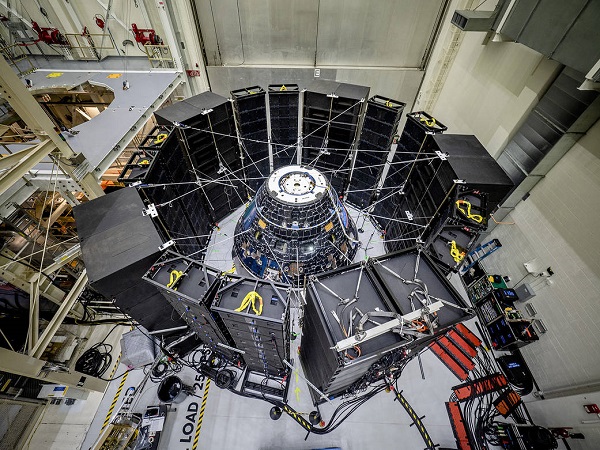As the White House requests an extra $1.6 billion for NASA's Artemis project, the agency moves forward with commercial partnerships.
| Update (May 23, 2019): NASA Director Jim Bridenstine has announced that the Colorado-based company Maxar will develop the propulsion, communications, and power elements for the Lunar Gateway outpost. |

NASA
NASA is moving ahead with plans to return astronauts to the Moon by 2024. Vice President Mike Pence announced the accelerated return in March. Last week saw a relatively small budget increase of $1.6 billion toward this initiative.
“This investment is a down payment on NASA's efforts, and will allow us to move forward with design, development, and exploration,” says NASA administrator Jim Bridenstine in a recent press release. “It will allow us to accelerate our development of the Space Launch System and Orion. It will support the development of a lunar landing system and it will support precursor capabilities on the lunar surface.”
What is Artemis?
The accelerated return to the Moon is being called Project Artemis, named after the goddess of the Moon in Greek mythology. NASA had already been planning to return to the Moon by the end of the 2020s, but the new initiative will see boots on the lunar surface by 2024. The new initiative still relies on the installation of a Lunar Gateway staging point in lunar orbit and will use the Space Launch System (SLS) heavy-lift rocket and the Orion capsule. The SLS is in development, and set for its first uncrewed flight in June 2020. Orion has already made one uncrewed flight (Exploration Flight Test 1) using a Delta IV Heavy rocket in 2014; it will make its first crewed flight in 2022.

NASA
Meanwhile, Northrop Grumman is working to have a version of the Lunar Gateway ready in time for 2024. Unlike the International Space Station, which has the internal area of a six-bedroom house, the Gateway will be more like a small studio apartment. The change in size reflects different functions, as the Gateway will likely only host crews for short stays, versus the permanent occupancy aboard the ISS.
The Artemis project envisions astronauts landing in the lunar south pole region, where permanently shadowed regions inside craters harbor water ice mixed with the lunar regolith. Bridenstine has also stated that Artemis will also put the first woman astronaut on the Moon.
Funding Artemis
The original FY2020 budget proposed for NASA was $21.019 billion dollars. Of that amount, $4.182 billion dollars was set toward human space exploration, including $1.315 billion dollars for continued operation of the International Space Station. The FY2020 budget request also contained $7.042 billion for the development of Deep Space Exploration Systems, including the Orion capsule, the SLS, and the Lunar Gateway.
The additional $1.6 billion proposed by the White House for the sped-up Artemis project would top NASA's FY2020 budget out at just over $22.6 billion — $1.1 billion more than the FY2019 budget, about a 5% increase.
There's no word what additional funding for the initiative would look like in coming years. Casey Dreier at the Planetary Society estimates that it would take an increase of $4 to 5 billion per year over the next 5 years to make a crewed lunar landing actually happen. Even that number may ultimately prove conservative, as internal NASA estimates place the final price tag at $40 billion.
By contrast, at the height of Apollo in the late 1960s, NASA's budget represented over 4% of the overall U.S. budget. Its current budget stands at around 0.5% of the national budget and has been stalled there for the past decade. None of the current increase touches other NASA funding earmarked for planetary and space exploration.
Another troubling factor is that this initial $1.6 billion dollar increase would shift surplus money from the student Pell grant program. This would not affect students currently enrolled in the program, but it's a disturbing precedent. Apollo, in comparison, occurred in the wake of Sputnik, and saw a parallel push to mint a new generation of scientists and engineers, in an effort to close the technology gap with the Soviets.

NASA / Radislav Sinyak
Fast forward to 2019, and the landscape has changed significantly — and become more uncertain. China has its sights of the Moon, having completed the first-ever lunar farside landing with Chang'e-4 in January 2019, and the country's space agency has announced plans for a lunar sample return mission in late 2019. However, many space pundits question whether these developments warrant a "space race redux." Analysts also wonder whether we even need the SLS, as SpaceX's Falcon Heavy is already flight-tested. Then again, SpaceX announced its own lunar ambitions in 2017, but its 2018 target date for a lunar flyby came and went.
In the end, the Artemis program may all come down to politics. Many see the 2024 deadline as politically motivated, as it would dovetail with the end of a possible second term for the current administration. The proposal may also stall in the House of Representatives, currently controlled by the Democrats. Certainly, drawing money from the Pell Grant program is bound to be a sore point. If, however, Congress opts to raise spending caps—which it has waived every year since 2013—we could see NASA get its funding increase for Artemis while leaving the Pell Grant program and other science projects untouched.
While we're in wait-and-see mode, NASA is already moving ahead with contracts for Artemis, including $45.5 million for 11 companies in the Next Space Technologies for Exploration Partnerships (NextSTEP), including Blue Origin, SpaceX, and Masten Space Systems. The grants, announced on May 16th, will go toward the design of various aspects of the Artemis program, such as lunar landers, hardware prototypes, and transfer vehicles.
The agency also announced on May 14th that it's awarding $106 million to small business for needed technology developments, such as foldable solar panels, magnetized connections for platforms being assembled in space, and autonomous aircraft.
“To accelerate our return to the Moon, we are challenging our traditional ways of doing business,” says Marshall Smith (NASA-HQ) in a recent press release. "We will streamline everything from procurement to partnerships to hardware development and even operations.”
All of this comes as we near the 50th anniversary of the first crewed landing on the Moon: the historic Apollo 11 mission. Only four of the 12 humans who walked on the Moon are alive today; it would be great to see their ranks replenished soon.
 0
0









Comments
You must be logged in to post a comment.